The AU smog chamber consists of a 1.63 x 1.63 x 1.85 m (H x W x L) cubic Teflon bag with a chamber volume of ∼ 5 m3. The chamber is suspended from a metal frame in a temperature-controlled cold room with a temperature range of – 16 to 26 °C. Inlet and sampling lines consists of certified clean stainless steel pipe entering the chamber bag at opposite sides.
The AU smog chamber allow for atmospheric simulation of the formation of aerosol from a wide variety of sources, biogenic as well as anthropogenic. Oxidation of volatile organic compounds (VOC) and subsequent aerosol formation can be performed by ozone reaction or photochemically through exposure to UV radiation. The temperature-controlled cold room allow for simulations of aerosol formation under a wide range of atmospheric condition.
State-of-the-art instrumentation situated outside the chamber continuously monitor the reactions of the investigated VOC along with the size, number, mass concentration and cloud forming abilities of the formed aerosols.
In addition, aerosols formed in the chamber can be collected for both real-time and off-line chemical analysis offering insight into the chemical composition of the aerosols.
Sea spray particles are formed under windy conditions when air-bubbles get entrained in the ocean by breaking waves. At the surface these bubbles burst resulting in release of droplets containing salt and other components to the atmosphere.
The Sea Spray Tank at the group of Atmospheric Physics and Chemistry is designed to imitate the formation and bursting of bubbles in the marine environment and the subsequently formation of sea spray particles.
The Sea Spray Tank consist of a 50 cm high 35 L stainless steal tank. A total of 20 L of sea water or solutions of known chemical composition can be added to the tank. The tank is temperature controlled within a range of -3 to 35 °C.
Bubble-busting, and thus particle formation, is implemented in one of two ways:
(1) Water is recirculated through a centrifugal pump and ejected through a nozzle 15 cm above the water surface.
(2) Clean air is pushed through a diffuser located at the bottom of the tank.
As particles are formed in the head space of Sea Spray Tank, these are transferred to adjacent instrumentation for the investigation of size, number, CCN capability, and chemical composition.
The size distribution of aerosol can be measured using a Scanning Mobility Particle Sizer (SMPS). The SMPS system consists of two separate instrumentations: a Differential Mobility Analyser (DMA) followed by a Condensation Particle Counters (CPC)
The DMA allow for the extraction of a selected size or the size distribution of aerosol particles. The system classifies charged particles according to their aerodynamic mobility using an electrical field.
The CPC allow for online measurement of the total aerosol number concentration. Particles collected through the CPC inlet are grown by condensing a super-saturated vapor onto the surface of the particles, forming particles large enough to be detected optically.
The SMPS system is widely used for the measurement of the concentration of fine particles (aerodynamic diameter < 1μm) in smog chamber experiment and the ambient atmosphere.
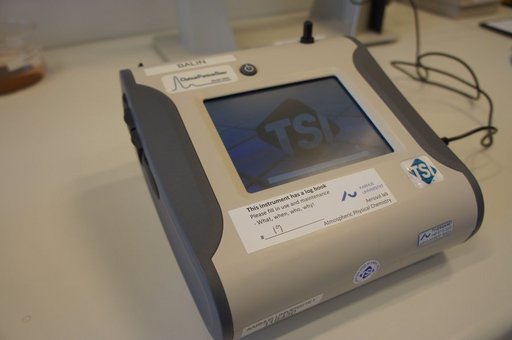
The TSI Optical Particle Sizer (OPS) is a light, portable unit that provides fast and accurate measurement of particle concentration and particle size distribution using single particle counting technology.
The OPS enables measurement of particles in the size range of 0.3 - 10 μm, thus stretching beyond the limitations of the SMPS system (<1μm particle size)
At the group of Atmospheric Physics and Chemistry the OPS is employed in conjunction with the SMPS systems, thus enabling accurate measure of particle number in the size range of 10 nm to 10 μm.

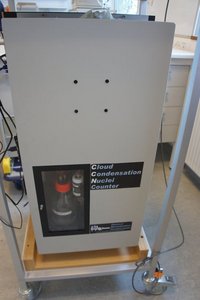
The Cloud Condensation Nuclei (CCN) counter is an instrument used for the measurement of the number concentration of cloud droplets in an aerosol at a given supersaturation. By exposing an aerosol to a variable water vapor supersaturation the CCN counter determines the activated fraction as a function of supersaturation for various aerosols.
The group of Atmospheric Physics and Chemistry at Aarhus University currently possess two separate CCN counters:The Wyoming CCNC-100B CCN Counter and the Droplet Measurement Technologies (DMT) CCN Counter.
The Wyoming CCNC-100B CCN Counter build at the Department of Atmospheric Science at the University of Wyoming.
The Wyoming CCN counter creates a water saturation vapor pressure gradient within a closed chamber. This is done by establishing a temperature gradient through the chamber, and thereby a region of supersaturation is created. By introducing an aerosol into the chamber the particles are subjected to supersaturation and a laser beam measures the concentration of CCN activated particles (NCCN).
By simultaneously measuring total particle concentration with a Condensation Particle Counter (CPC) the fraction of activated particles (NCCN/NTOTAL) is found.
The Droplet Measurement Technologies (DMT) CCN Counter
The DMT CCN counter is a continuous-flow thermal-gradient diffusion chamber consisting of 50 cm long columns. Inside the columns, a thermodynamically unstable, supersaturated water vapor condition is created. The supersaturated water vapor condenses on the cloud condensation nuclei in the sample air to form droplets, just as cloud drops form in the atmosphere. As the introduced aerosols in the sample air is transformed into cloud droplets Optical Particle Counter (OPC) using side-scattering technology counts and sizes the activated particles.
In the group of Atmospheric Physics and Chemistry, the CCN counters are used to examine the cloud forming abilities of particles from different sources, such as sea spray particles and natural and anthropogenic particles formed from for the gas-phase oxidation of volatile organic compounds.
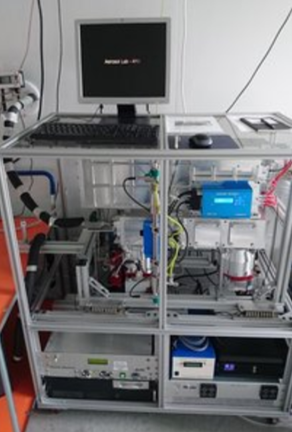
The Aerodyne High Resolution Time-of-Flight Aerosol Mass Spectrometer (HR-TOF-AMS) provides quantitative size and chemical mass loading information in real-time for non-refractory sub-micron aerosol particles. The AMS couples size-resolved particle sampling and mass spectrometric techniques into a single real-time measurement system.
The HR-TOF-AMS is currently used for real-time real-time analysis of the chemical composition of particles injected or formed in the Cold Room Smog Chamber. The system is mobile and may be deployed for ambient measurements during field campaigns.
The thermodenuder (model 3065 Low-Flow Thermodenuder, TSI Inc.) enables measurement of the volatility of aerosol particles. The aerosol sample flows through a long glass tube that can be heated to a desired temperature. Volatile organic compounds may evaporate due to the high temperatures and thus change the properties, such as size and chemical composition of the particles.
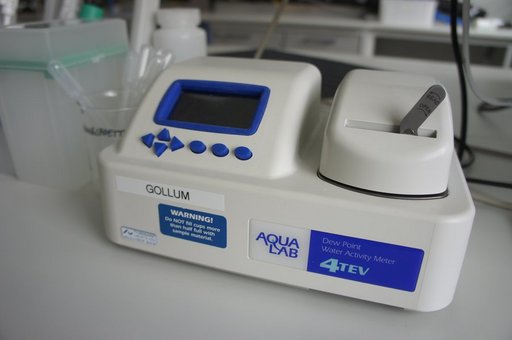
Water activity (aw) describes the energy status or escaping tendency of water in a sample. It indicates how tightly water is “bound,” structurally or chemically, in a solution or solid.
The AquaLab Dew Point Water Activity Meter measures the water activity as the ratio of the vapor pressure of water in a material (p) to the vapor pressure of pure water (po) at the same temperature.
At the group of Atmospheric Physics and Chemistry we investigate how the water activity of atmospheric particles is affected by the chemical composition of the particles. Water activity measurements of solutions often comprising atmospheric particles provide data used to calculate the supersaturation required for particles to activate as cloud condensation nuclei (CCN), thus form clouds in the atmosphere.
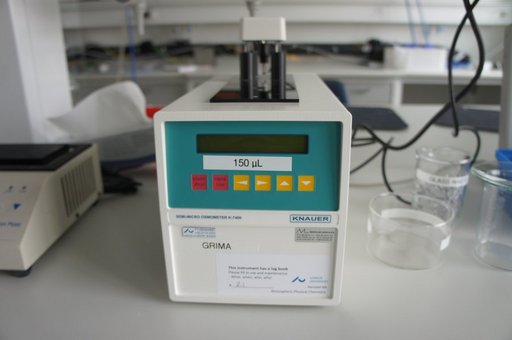
The Osmometer allow for accurate determination of osmolality by measuring the freezing point depression of a liquid sample.
The osmolality of a solution gives the number of moles of osmotically active species in one kg of water.
By simple calculations water activity (aw) of a solution can be determined from the osmolality as measured by the Osmometer. The Osmometer thus enables an alternative approach for determination of the water activity compared to the Dew Point Water Activity Meter.
Low sample volume requirement of the Osmometer (0.15 mL) compared to the Dew Point Water Activity Meter (approx. 7.5 mL) allow for accurate aw measurements to be performed on samples of low volume.
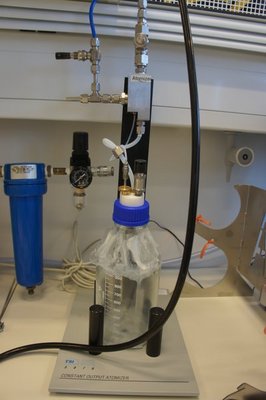
Atomizers, such as the TSI 3076, enable the production of aerosols by spraying droplets of water or a solution.
A solution containing the compounds of which particles are to be produced is drawn from a closed bottle connected to the atomizer. Pressurized VOC-and particle-free air is fed to the main unit and expanded through a small nozzle. This creates a jet of high velocity and upon entry liquid is atomized into droplets. Larger droplets impact on the inner back wall and run back to the solution bottle, while smaller droplets continue onwards within the air flow through the output of the atomizer. Subsequently, the aerosol flow is dried by silica diffusion dryers and a Nafion® dryer so that the water evaporates and the solid residual is left as aerosol particles. This procedure produces aerosols with particle in the nanometer regime.
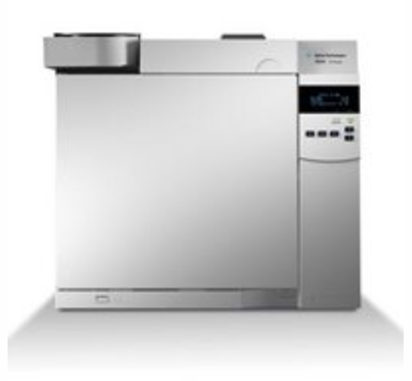
The Agilent 7820 GC system with gas valve inlet system allow for close to online measurement of volatile organic compounds (VOC) in the gas phase. The system utilizes the highly sensitive Flame Ionization Detector enabling the detection of atmospheric relevant concentrations of VOCs, such as isoprene, pinene and toluene.
The GC-FID is a part of the instrumental array connected to the newly developed environmental chamber at the group of Atmospheric Chemistry and Physics at Aarhus University.
Saturation vapour pressure and the associated temperature dependence (enthalpy ΔH), are key parameters for improving predictive atmospheric models. Generally, the aerosol community lack experimentally determined values of these properties for atmospheric relevant organic aerosol compounds.
One technique to determine saturation vapour pressures is from measured evaporation rates of aerosol particles.
ARAGORN (AaRhus Atmospheric Gasphase OR Nanoparticle) - flow tube setup enables the experimental determination of the evaporation rates of organic aerosol particles.
Sub-micron particles are generated by nebulization from aqueous solution, dried, and a mono disperse fraction of the aerosol is selected using a differential mobility analyser (DMA). The particles are then allowed to evaporate in the ARAGORN-flow tube that is the central part of the system. It is a 3.5 m long stainless steel pipe with an internal diameter of 0.026 m. Along its length, the flow tube has four ports that can be used for aerosol particle sampling, and measurements of temperature, relative humidity and pressure. Changes in particle size as function of evaporation time are determined using a scanning mobility particle sizer system (SMPS). Physical properties like air flows, temperatures, humidity and pressure are controlled and monitored on several places in the setup.
The saturation vapour pressures are then inferred from the experimental results in the MATLAB® program AU_VaPCaP (Aarhus University_Vapour Pressure Calculation Program).